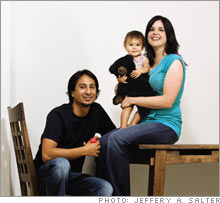Prescription for the FutureA young doctor and family are off to a good start, but soon they'll have to learn to handle real money(Money Magazine) -- Sonya and Nop Unnoppet never got to thank the man who introduced them: He was dead at the time. Nop - his parents are from Thailand, where his full name, Nopporn, is common - was a medical student in 2000, teaching dissection to aspiring physician's assistants.
Sonya was an attentive student. In 2003 they married, and last year daughter Fin was born. Sonya, 31, has worked for six years and even paid off $63,000 in student loans. As for Nop - well, at 35 he's still a student, working on a fellowship in rheumatology. He's making just $38,000. But when he enters private practice in 2009, his earnings should soar to $200,000 a year. "I'm not sure how we'll handle that," Nop says. The Unnoppets, who live in Clearwater, Fla., have been model savers. But Sonya, who's done the mutual fund picking, admits she's made choices because "I liked the way they sounded. I don't know what I'm doing." That needs to change before large sums are at stake. Where they are now The Unnoppets salt away 16 percent of their combined $90,000 income. They have $76,000 in retirement savings as well as a $30,000 emergency fund. Unlike their saving skills, their spending habits are haphazard. They don't have a budget when it comes to, say, their annual five-day snowboarding vacation. "We just buy the plane tickets," Sonya admits. As for their debts, when Nop starts to practice they'll begin repaying $175,000 in medical school loans. They carry two mortgages on their home: They owe $138,000 on a seven-year ARM. And earlier this year Sonya took out a $40,000 second mortgage to buy 90 acres with her father in New Haven, Ky., her hometown. The couple plan to relocate to that state or to Alabama, where Nop is from, in 2009. What they should do The Unnoppets need to cultivate financial discipline so it becomes second nature by the time Nop is making six figures, says Thomas Balcom, a Miami financial planner. "When people make more, they spend more," he says. "But they shouldn't change their saving habits." In fact they'll need to put away a lot more: The couple hasn't started saving for their daughter's college education, and Nop hopes to retire at 60, after practicing for just 25 years. Here are steps they should take now: Adopt a strategy Sonya compares her investment style to "picking a horse at the Kentucky Derby." The result is an out-of-whack portfolio overly invested in the stocks of big companies. Balcom recommends they construct a more diversified mix that includes small-cap stocks and inflation hedges such as real estate investment trusts and commodities, using the funds available in Sonya's 401(k), and Money 70 funds for their IRAs. The couple doesn't need bonds now, Balcom says. They have a long investment horizon, and the land Sonya owns with her dad will crank out a bond-like stream of steady income - they'll rent it out to soybean farmers and loggers. Buy more life insurance Nop will be the sole breadwinner when he joins a practice and Sonya becomes a stay-at-home mom. He needs a $1 million term policy; hers should be at least $300,000. Total cost: $150 a month. Keep spending smart Nop and Sonya enjoy spending money - he on gadgets, she on baby clothes. They've shown admirable restraint to date. They'll need to keep at it. As Balcom puts it: "You don't want a consumer explosion 20 months from now." Want a Money Makeover? E-mail us at makeover@moneymail.com. Get on track for retirement Hedge funds vs. mutual funds Money 70: Best mutual funds From the August 1, 2007 issue
|
| ||||||||||||||


